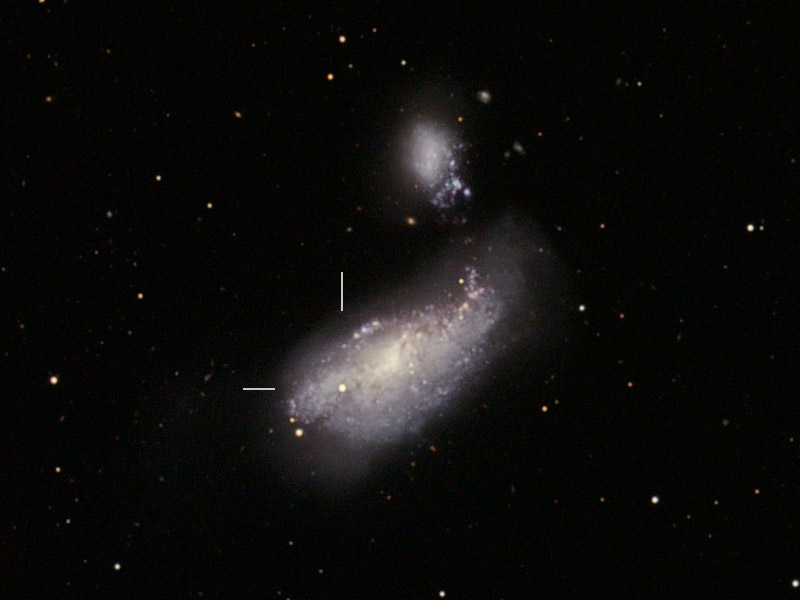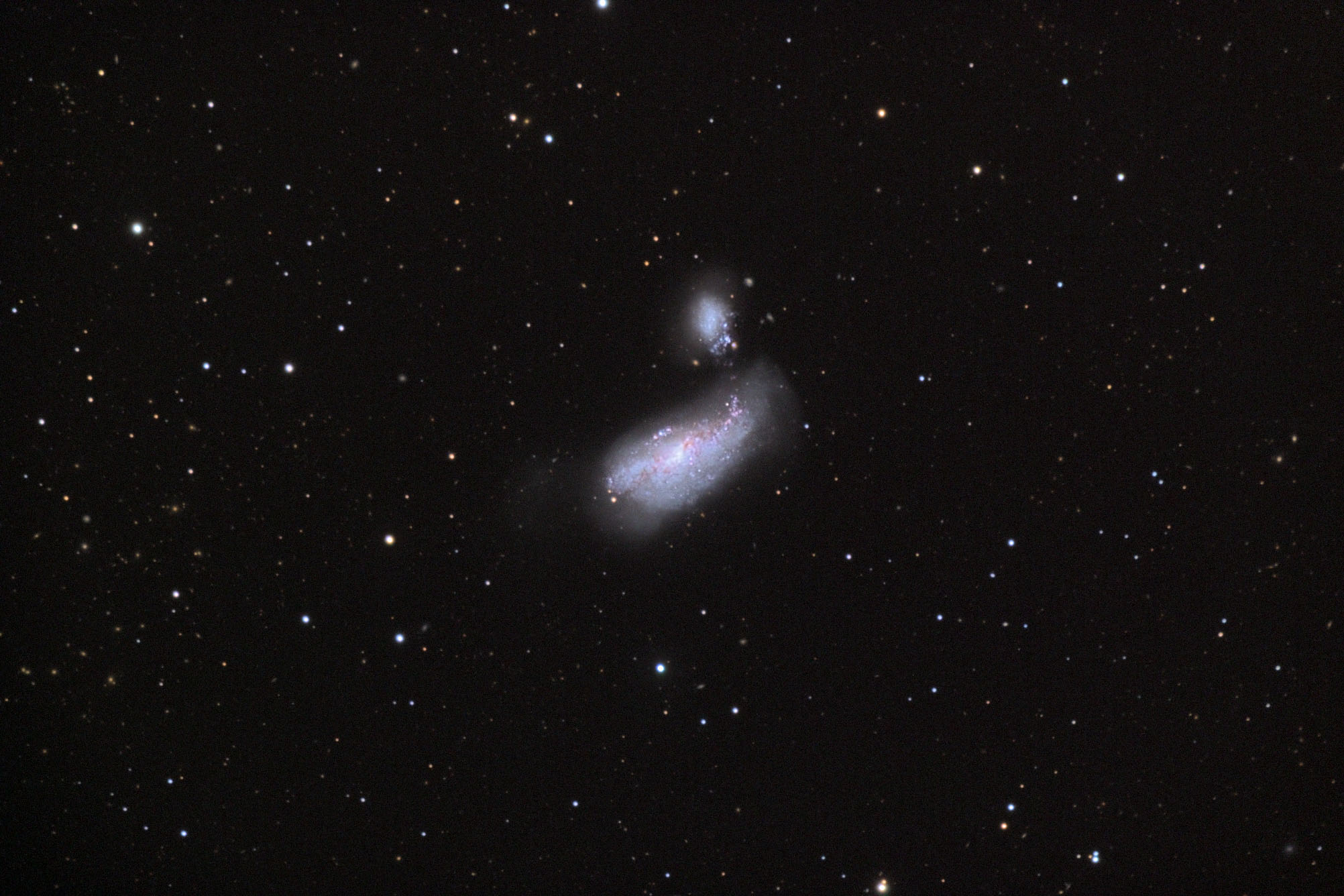Object name: NGC4490Designation(s): NGC4490, NGC4485, ARP269, Arp 269 is made up of NGC 4485 and NGC 4490. The big one is NGC 4490 which is sometimes known as the Cocoon Galaxy. They are located in Canes Venatici which is high overhead in the evening this time of year. These two have had a near collision that has ripped stars out of both and started massive star formation in them as shown by the many bright HII regions (pink). NGC 4490 gets the Cocoon name for being embedded in a faint cocoon of stars much as a pupa is in a cocoon. I've posted two versions of this guy. The first as it is more normally seen and then a very deep processing to better show the cocoon of stars that surrounds it. The distance to these two is rather vague. I see published papers giving distances ranging from 25 to 60 million light years. Those citing about 35 million seems better researched so that's what I'll go with. There's very little on the net about these guys other than published papers so I don't have any links that are of much use here. I would have thought it a target for Hubble but it isn't in their database that I can find. But Chandra has looked at it in X-ray light.
http://chandra.harvard.edu/graphics/press/03_releases/052703_images/ngc4485.jpg while an HST image of NGC 4485 can be seen at: http://cseligman.com/text/atlas/ngc4485hst.jpg
Arp put it in his classification for Group Character: Connected Arms. I don't see how this pair varies from many other interacting pairs he put under other categories in his atlas. NGC 4485 to the north is classified as IB(s)m pec while NGC 4490 is classified at NED as SB(s)d pec. The pair was discovered by William Herschel on January 14, 1788. Both are in the original Herschel 400 observing program as two individual listings. My notes from April 28, 1984 with a 12.5" f/6 telescope at up to 150x on an excellent night in the New Mexican desert read: "Small and dim with no detail. In the same field with much larger and brighter NGC 4490. A Mutt and Jeff pair. Appears slightly elongated. Hard to judge this one as my eye keeps jumping to NGC 4490." The entry for NGC 4490 reads: Bright with stellar nucleus. Some detail seen in arms. Appears to be a highly tilted spiral. A bit more tilted than M31. A fine object especially when paired with NGC 4485. Seems about 9.5 magnitude, brighter than Burnham says." It's obvious I'd not seen anything on this pair before looking at it as I thought I was looking at a classic spiral rather than a messed up one with no defined arms.
Our galaxy is very over due for a naked eye super nova event. Not one has blown in our galaxy, that we could see that is, since the invention of the telescope much to astronomer's dismay. We find them all the time in very distant galaxies where they are faint and difficult to study. So when one blows in a near by galaxy it causes lots of observatories to drop what they were doing and get their instruments trained on the exploding star. One did so in NGC 4490 shining "brightly". It blew in 2008 and is known as 2008ax being discovered on March 3 by Link Observatories automated supernova search telescope and by Japanese amateur Koichi Itagaki who has discovered over 100 supernova. This one was bright enough to be seen in amateur telescopes of 8" or larger size when viewed from a very dark location. It is shining at magnitude 13.2 as best as I can measure it against the background of the galaxy in my image.
The distance to NGC 4490 is a bit uncertain. I've seen estimates from 35 to 50 million light years. Maybe they'll have to pin it down a bit closer to get meaningful results from the study of this supernova. This is a very blue galaxy in which star birth has been going on at an extremely high rate due to interaction with a companion galaxy NGC 4485 also in the image. Many of these new stars are super-massive blue giants that are very short lived. Lasting only a few million years before they blow up. So it isn't at all surprising to find a supernova in this galaxy. My super nova image was taken in strong moonlight and had very limited color data due to clouds and lousy seeing. But it does show the supernova when it was about 13.5 magnitude. It apparently brightened a bit after my image was taken. Of course all this really happened at least 35 million years ago so this is old news to residents of the galaxy, assuming they could survive living in such an active galaxy with the intense radiation caused by its star birth condition. Be very glad we don't live in such a galaxy. The pink regions easily seen in my image are due to HII emission from areas where star birth is still going on. My lousy seeing and limited color data makes them hard to see in the super nova image.
Arp's image:
http://ned.ipac.caltech.edu/level5/Arp/Figures/big_arp269.jpeg
14" LX200R @ f/10, L=4x10' RGB=2x10', STL-11000XM, Paramount ME Related Designation(s):11HUGS 288, 11HUGS 289, 2MASX J12303111+4142042, 2MASX J12303636+4138370, 2MASXi J1230311+414200, 2MASXi J1230368+413825, 2XMM J123035.9+413840, 2XMMp J123035.9+413840, 87GB 122809.0+415515, 87GB[BWE91] 1228+4155, ARP 269, ARP 269 NED01, ARP 269 NED02, ARP 269:[FHL2008] 27, ARP 269:[LM2005] ULX04, ARP269, B3 1228+419A, CGCG 1228.0+4159, CGCG 1228.1+4155, CGCG 216-007, CGCG 216-008, CXO J123036.2+413838, CXO J123036.26+413837.9, CXOU J123036.2+413837, CXOU J123036.2+413838, CXOU J123036.3+413837, HDCE 0706 NED071, HDCE 0706 NED072, HIJASS J1230+41, HOLM 414, HOLM 414A, HOLM 414B, IRAS 12281+4155, IRAS F12281+4155, ISOSS J12305+4139, IXO 62, KPG 341, KPG 341A, KPG 341B, KUG 1228+419, LCSB L0518O, LDCE 0867 NED116, LDCE 0867 NED117, LGG 290:[G93] 008, LGG 290:[G93] 015, MCG +07-26-013, MCG +07-26-014, NGC 4485, NGC 4485:[RW2000] X-01, NGC 4490, NGC 4490:[FHL2008] ULX-6, NGC 4490:[FK2005] 15, NGC 4490:[L2011a] X0005, NGC 4490:[LB2005] X01, NGC 4490:[MGS2012] 01, NGC 4490:[RPS97] 03, NGC 4490:[RW2000] X-02, NGC 4490:[WMR2006] XMM2, NGC4485, NGC4490, NSA 141527, PGC 041326, PGC 041333, RX J1230.5+4139, SDSS J123030.96+414201.4, UGC 07648, UGC 07651, USGC U480 NED10, USGC U480 NED11, UZC J123031.4+414201, UZC J123036.1+413834, VLSS J1230.5+4138, VV 030, VV 030a, VV 030b, WSRT-CVn [KOV2009] 67A, WSRT-CVn [KOV2009] 67B, [BDT2013] 14, [DMA2007] J123036.33+413837.78, [H92] 25, [M98j] 170 NED59, [M98j] 170 NED60, [SGT2004] J123036.32+413837.8 , [SLK2004] 0716, [SST2011] J123036.32+413837.8 , [STS2009a] J123036.32+413837.8, [TCW2007] 123, [TCW2007] 124, [VHC2007a] ULX5, [WB92] 1228+4155, | | 
